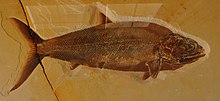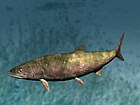
The Amiiformes order of fish has only two extant species, the bowfins: Amia calva and Amia ocellicauda, the latter recognized as a separate species in 2022. These Amiiformes are found in the freshwater systems of North America, in the United States and parts of southern Canada. They live in freshwater streams, rivers, and swamps. The order first appeared in the Triassic, and the extinct members include both marine and freshwater species, many of which are morphologically disparate from bowfins, such as the caturids.
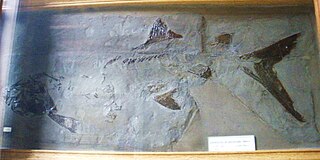
Chondrosteus is a genus of extinct marine actinopterygian belonging to the family Chondrosteidae. It lived during the Hettangian and Sinemurian in what is now England. Chondrosteus is related to sturgeons and paddlefishes as part of the clade Acipenseriformes, and is one of the earliest known definitive members of the group. Similar to sturgeons, the jaws of Chondrosteus were free from the rest of the skull. Its scale cover was reduced to the upper lobe of the caudal fin like in paddlefish.

Dapedium is an extinct genus of primitive marine neopterygian ray-finned fish. The first-described finding was an example of D. politum, found in the Lower Lias of Lyme Regis, on the Jurassic Coast of England. Dapedium lived in the Late Triassic to the Middle Jurassic period, from the late Norian to the early Aalenian.

Saurichthys is an extinct genus of predatory ray-finned fish from the Triassic Period. It is the type genus of the family Saurichthyidae, and the most speciose and longest lasting genus in the family. This family also includes the Permian Eosaurichthys (China) and the Jurassic Saurorhynchus from Europe and North America, though it may be more appropriate to treat these as subgenera of Saurichthys, due to the genus Saurichthys otherwise being paraphyletic.

Aspidorhynchus is an extinct genus of predatory ray-finned fish from the Middle Jurassic to the earliest Cretaceous. Fossils have been found in Europe, Antarctica and the Caribbean.
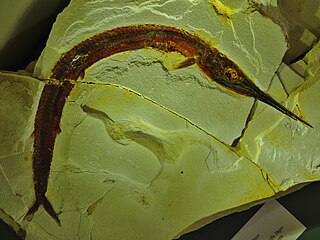
Belonostomus is a genus of prehistoric ray-finned fish that was described by Louis Agassiz in 1844. It is a member of the order Aspidorhynchiformes, a group of fish known for their distinctive elongated rostrums.

Palaeocoma is an extinct genus of brittle stars that lived during the Middle Triassic to Early Jurassic Periods. Its fossils have been found in Europe.

Cricosaurus is an extinct genus of marine crocodyliforms of the Late Jurassic. belonging to the family Metriorhynchidae. The genus was established by Johann Andreas Wagner in 1858 for three skulls from the Tithonian of Germany. The name Cricosaurus means "Ring lizard", and is derived from the Greek Krikos- ("ring") and σαῦρος -sauros ("lizard"). It was a relatively small reptile, with C. suevicus and C. araucanensis measuring 2 m (6.6 ft) and 3.2 m (10 ft) in total body length, respectively.

Ainia is an extinct genus of prehistoric ray-finned fish that lived during the Kimmeridgian stage of the Late Jurassic epoch. It contains a single species, A. armata, known from the famous Solnhofen Limestone of Germany. It is a distant relative of the bowfin, although it is more closely related to genera such as Caturus and Osteorachis.
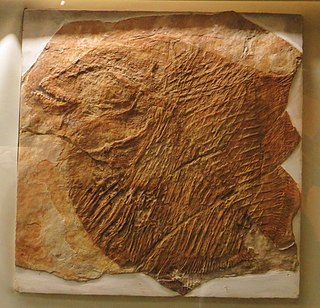
Coelodus is an extinct genus of marine and possibly freshwater pycnodont fish. It contains only one definitive species, C. saturnusHeckel, 1854, from the Late Cretaceous of Slovenia. Other species from the Late Jurassic to the Eocene have also been attributed to this genus based on isolated dental elements, but their assignment to Coelodus is uncertain, and this genus likely represents a non-monophyletic wastebasket taxon. A potential diagnostic trait is a prearticular tooth row with three regular highly elongated teeth.

Coccolepis is an extinct genus of prehistoric marine ray-finned fish in the family Coccolepididae. Originally including most species within the family, it is now restricted to two species from the Late Jurassic Solnhofen Limestone of Germany. The holotype of C. bucklandi, designated and described by Louis Agassiz, was thought to be lost but was later rediscovered in Neuchâtel.

Squaloraja is an extinct genus of ray-like marine chimaeriform fish from the Early Jurassic of Europe.

Coptoclavidae is an extinct family of aquatic beetles in the suborder Adephaga. The Coptoclavidae lived from the Late Triassic to the Early Cretaceous. Coptoclavidae is a member of the adephagan clade Dytiscoidea, which contains other aquatic beetles. Suggested reasons for their extinction to include the rise of teleost fish, or competition with Gyrinidae and Dytiscidae, which possess defensive secretions and sucking channels in the mandibles of larvae, which coptoclavids likely lacked. It has been suggested that the genus Timarchopsis and the subfamily Timarchopsinae are only distantly related to other coptoclavids based on cladistic analysis, with Timarchopsis being more closely related to geadephagans like carabids and trachypachids instead. Another study also suggested similarly for Coptoclavisca and possibly other coptoclaviscines.

Omma is a genus of beetles in the family Ommatidae. Omma is an example of a living fossil. The oldest species known, O. liassicum, lived during the final stage of the Triassic (Rhaetian), over 200 million years ago, though the placement of this species in Omma has been questioned. Numerous other fossil species are known from the Jurassic and Cretaceous of Europe and Asia. The only living species is Omma stanleyi, which is endemic to Australia. Three other extant species endemic to Australia that were formerly part of this genus were moved to the separate genus Beutelius in 2020.Omma stanleyi is strongly associated with wood, being found under Eucalyptus bark and exhibiting thanatosis when disturbed. Its larval stage and many other life details are unknown due to its rarity. Males are typically 14–20 mm in length, while females are 14.4-27.5 mm. Omma stanleyi occurs throughout eastern Australia from Victoria to Central Queensland.

Caturidae is an extinct family of predatory fishes belonging to the order Amiiformes. The earliest members of the family appeared in the early Late Triassic, reaching an apex of diversity during the Jurassic. The youngest records of the group date to the Early Cretaceous. Members of the family include Caturus, Strobilodus, Amblysemius, and Catutoichthys.

Ophiopsiella is an extinct genus of prehistoric ray-finned fish.
Mesoblattinidae is an extinct, problematic family of cockroaches known from the Mesozoic. It was formerly considered a wastebasket taxon for Mesozoic cockroaches, but the family has subsequently been better defined, with many taxa transferred to Caloblattinidae. It is considered to have close affinities with Blattidae and Ectobiidae, as well as possibly Blaberidae. The family first appeared by the Early Jurassic. They are considered to represent amongst the oldest groups of modern cockroaches, and like them are thought to have laid oothecae. Due to the poor ability of forewing venation to correctly classify cockroaches to extensive homoplasy, the value of this family as a taxonomic unit has been strongly questioned, with some authors considering the family a nomen dubium.

Necrotauliidae is an extinct family Mesozoic Amphiesmenoptera. While previously considered a paraphyletic grouping of "basal Trichoptera, basal Lepidoptera, and advanced stem-Amphiesmenoptera", they have recently been considered early diverging caddisflies. Other authors have considered them to be basal amphiesiopterans.

Orthophlebiidae is an extinct family of scorpionflies known from the Triassic to Cretaceous, belonging to the superfamily Panorpoidea. The family is poorly defined and is probably paraphyletic, representing many primitive members of Panorpoidea with most species only known from isolated wings, and has such been considered a wastebasket taxon.

Coccolepididae is an extinct family of ray-finned fish, known from the Early Jurassic to Early Cretaceous, most of which were originally referred to the type genus Coccolepis. They had a widespread distribution, being found in North and South America, Australia, Asia and Europe. They are mostly known from freshwater environments, though several species have been found in marine environments. They are morphologically conservative, and have poorly ossified endo and exoskeletons, which usually results in poor preservation. This makes it difficult to distinguish species. They are generally small fish, with the largest known specimens reaching a length of 210 mm. Historically, they have been classified as members of “Palaeonisciformes”, a paraphyletic grouping of non-neopterygian fish, due to their plesiomorphic conservative morphology closely resembling those of many other groups of primitive fish. Some recent authors have suggested that they may belong to the order Chondrostei as relatives of the Acipenseriformes.
